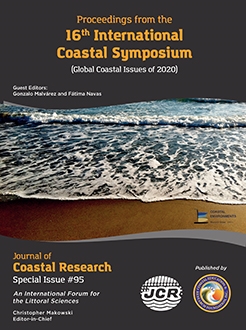Shariful, F.; Sedrati, M.; Ariffin, E.H.; Md Shubri, S., and Akhir, M.F., 2020. Impact of 2019 tropical storm (Pabuk) on beach morphology, Terengganu coast (Malaysia). In: Malvárez, G. and Navas, F. (eds.), Global Coastal Issues of 2020. Journal of Coastal Research, Special Issue No. 95, pp. 346-350. Coconut Creek (Florida), ISSN 0749-0208.
Occurrences of tropical storms, including cyclone and typhoon, across the Southeast Asia region are uncommon despite being highly prone to monsoon storm. Nevertheless, Thailand was recently hit by a cyclone called Pabuk, which had affected several parts of Malaysia with a significant impact along the Terengganu coastal area, particularly its infrastructure erected along the coastal line. This Pabuk storm was associated with the direction of waves, along with intense current velocities and strong winds, in comparison to a normal monsoon storm. The Pabuk storm had struck the Terengganu coastal area precisely in January 2019, which was during the Northeast monsoon storm that commonly occurs between November and January with heavy rainfall and strong wind. Interestingly, in November and December 2018, the rainfall was minimal to only a few drops, while the weather was hot and dry. In order to comprehend the variances between seasonal monsoon and the Pabuk storm, beach profile surveys were conducted during monsoon seasons, including the Southwest monsoon (June 2018), the transition monsoon (October 2018), the Northeast monsoon (December 2018), and after the Pabuk storm. In particular, during the Northeast monsoon season, erosion was absent along the beach, except for some discovery in the anthropogenic area, while the beach volume decreased from the beach dune and foreshore areas after the Pabuk storm. This study revealed that the highest significant wave height from numerical model (MIKE-21) during the Pabuk storm inflicted a significant morphological change onto the beach dune. Since the recovery of beach dune varies depending on the availability of sediment source, the recovery process may take a longer period in the anthropogenic areas. Such findings are integral for coastal managers involved in repairing and rebuilding activities on the adversely affected coastal infrastructures along the coastal line at the event of tropical storm.





